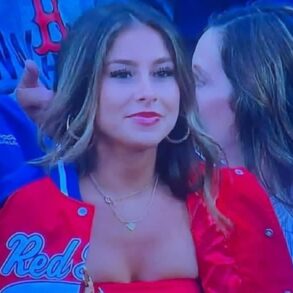
Major League Baseball’s amateur draft is just over a month away, with the first pick due on the evening of Sunday, July 13. That makes this the opportune time to rank some draft prospects.
Below, you’ll find my assessment of the top 30 players in this class. As is the case each summer, I’ve compiled this list after talking with various front-office personnel (including but not limited to scouts and analysts); doing my own statistical and observational research; and digging into what history says about certain profiles. My goal is for this to be a blended list: partially where I expect players to go in the draft, and partially where I would rank them on talent alone.
With that fine print out of the way, let’s get to it.
1. Eli Willits, SS, Fort Cobb-Broxton HS (OK)
Willits is considered to be the other prep shortstop with big-league bloodlines near the top of the class, but I ranked him aggressively in the spring and I see no reason to not do the same here. Reggie’s son is a surefire shortstop with all the necessary weaponry to be a plus or better defender at maturation. He’s also a promising switch-hitter with strong bat-to-ball and zone-management skills (though he seems unlikely to get to even average power). As an added bonus, Willits won’t celebrate his 18th birthday until December — studies have shown that such competence at a young age tends to bode well for the player’s long-term outlook. I don’t know that he’ll go No. 1, but I would be shocked if he’s available outside of the top five.
2. Kade Anderson, LHP, LSU
Anderson is a four-pitch lefty who survived an SEC vetting. What more do you need to know? Maybe that he possesses a low-90s fastball, two breaking balls (including a harder slider), and a changeup that generated ample whiffs against right-handed batters. And possibly that he’s also shown good control over his pitches, averaging fewer than two walks per appearance. It’s a strong year for collegiate lefties at the top of the draft, but Anderson might be the safest of the top three collegiate lefties. That’s why some veteran evaluators I’ve spoken with lately have predicted that he’ll be the No. 1 pick when the Nationals make their selection next month, and that’s why I’ve given him the nod above his peers, even if there’s reasonable arguments to be made for each.
3. Liam Doyle, LHP, Tennessee
Doyle was the breakout star of the college baseball season, hanging his star at the onset by striking out 47 batters in his first 20-plus innings. He didn’t maintain that pace the rest of the way (how could he?), but he did lead the country in strikeout rate (42.6%). Doyle may find himself under the microscope for a few reasons. Foremost, he rode his mid-90s fastball so hard that his usage rate would’ve been highest among qualified MLB starting pitchers. Of course, it’s hard to knock him for embracing what proved to be a winning strategy, and to his credit he did show enough promise with his other pitches (including a slider and change) that this may prove to be a non-factor. Another aspect of Doyle’s game that could give teams pause: a propulsive delivery that often sees his hand point down at foot strike. It is worth noting that Doyle walked batters at roughly the same rate as Jamie Arnold, suggesting his control might be just fine.
4. Jamie Arnold, LHP, Florida State
Arnold, my preseason No. 1, was unable to match last season’s statistical brilliance. His ERA and walk rate increased year over year while his strikeout rate and innings count decreased. Despite the slippage, there’s still plenty to like. Arnold has a full arsenal — two low-to-mid-90s fastballs, a slider, and a newly minted split-change — that he delivers from a sidearm slot, creating a flat plane to the top of the strike zone. His delivery, which looks like someone spliced together aspects of Clayton Kershaw and Chris Sale, does require his elbow to creep above the shoulder line — an element that evaluators point to as a concern with respect to command and durability. Provided teams don’t have too much concern about that, he should come off the board early.
5. Ethan Holliday, 3B/SS, Stillwater HS (OK)
The famous player in this year’s draft. Holliday is the son of a former All-Star and the brother of a future one, placing enormous (and probably unfair) expectations on his own career. Fortunately, he’s an intriguing prospect who might end up going No. 1 overall, thereby matching his brother and becoming the first set of siblings to each be chosen at the top of the draft. Anyway, Holliday is likely to end up at third base before all is said and done, but the real selling point here is and will remain his bat. He’s a lefty hitter with a good approach and big-time strength, giving him the kind of on-base and slugging capacity that could entrench him in the middle of an order. Scouts do still have concerns about his contact chops, but they were encouraged by his decision to add a toe tap to his operation this spring and believe he’ll work to get the most from his talent.
6. Billy Carlson, SS, Corona HS (CA)
Carlson is technically a two-way player, but I don’t anticipate he’ll ever pitch as a professional. His strong right arm should come in handy anyway, forming part of an impressive defensive package with his quality hands and smooth actions. Carlson holds some offensive promise, too, as he employs a line-drive stroke with a chance at accessing average or better juice. It’s possible that at maturation Carlson boasts five average or better tools. Even shy of that, his defensive acumen gives him a high enough floor to justify a selection in the top half of the first round.
7. Aiva Arquette, SS, Oregon State
I’m listing Arquette as a shortstop because that’s where he played this season, but precedent says someone of his size will end up moving off the six. There’ve been just three players his listed height (6-foot-5) or taller to appear in 50 or more games at shortstop in a single season during the wild card era: Mike Morse, Oneil Cruz, and Elly De La Cruz. If and when Arquette has to relocate, he should be able to slot in at third base just fine thanks to a strong arm and capable hands. Offensively, his best attribute is his good power. He saw both his strikeout and walk rates improve this year, though evaluators continue to have concerns about his swing-and-miss tendencies — especially since they stem from him having long limbs. Arquette still ought to be the first college position player drafted.
8. Kyson Witherspoon, RHP, Oklahoma
Witherspoon is a tier below the left-handers listed above, but he should become the fourth collegiate arm to hear his name on draft night. He improved his game across the board this season, from upping his strikeout-minus-walk percentage (14.1% to 25.9%) to padding his arsenal. Witherspoon, still ever capable of chucking his mid-to-upper-90s heater, now has three other distinct pitches he’s comfortable using as needed: two breaking balls and a cutter. As for his quick arm stroke — and trust that it’s quicker than this aside — it’s worth noting that even during conference play he walked fewer batters than the other top collegiates.
9. Gavin Fien, SS/3B, Great Oak HS (CA)
One of two Gavins on this list, Fien is a prepster in possession of a high ceiling. (Gavin Kilen, meanwhile, is a no-frills collegiate bat.) He’s a projectable right-handed hitter with good strength and an advanced eye. The scouts I’ve spoken with believe that he’ll outgrow shortstop, likely necessitating a move over to the hot corner. Sometimes those expectations prove to be premature or incorrect — look no further than Phillies prospect Aidan Miller, who seems far more likely to stick at short now than he did entering the 2023 draft. Regardless, Fien should make his way to the podium sometime within the first 15 or so picks on draft night.
10. Seth Hernandez, RHP, Corona HS (CA)
Hernandez is arguably the most polarizing player in the class because of the clash between the macro and the micro. Empirically, prep right-handers are a terrible bet to make in the early stages of the draft, to the extent that I can’t bring myself to rank him above this, even while accepting that he’s certain to go higher (and yes, possibly even No. 1 overall). Is it fair to hold someone else’s history against Hernandez? That’s where opinions may differ. If you’re just weighing him on his own merits, he’s a physical, live-armed righty with a good changeup and a feel for spin. You can envision this working, and possibly working out well — you just have to block out the howls of failures past to do it.
11. JoJo Parker, SS, Purvis HS (MS)
Parker can really swing it from the left side, earning plus hit tool projections with the chance for average or better power to follow. He’s also likely to remain somewhere on the dirt, albeit probably not at shortstop. That combination has enabled him to climb boards over the spring and summer, with the scouts that I spoke with predicting he’ll go within the first dozen picks. Do note that Parker’s twin brother Jacob, an outfielder, is also in this class. Both are committed to Mississippi State.
12. Kayson Cunningham, SS/2B, Johnson HS (TX)
Cunningham is one of the most polished prep hitters in the class. He combines a mature left-handed swing with an appreciable feel for contact and the strike zone alike. Two factors will determine where he lands in the draft. One, where teams project him defensively, and two, how clubs feel about his age. The scouts I’ve talked to are optimistic he’ll remain up the middle, albeit maybe not at shortstop. Meanwhile, Cunningham will celebrate his 19th birthday in late June, putting him on the older side for a high school player. There’ve been enough recent overage success stories (Bobby Witt Jr. included) to think the positional question will carry more weight.
13. Jace LaViolette, OF, Texas A&M
Back in the spring, I described LaViolette as the Aaron Judge of college baseball: a towering, sneakily athletic offensive powerhouse with extreme power, plate discipline, and swing-and-miss tendencies. That comparison, while a good thing in certain respects, made it difficult to forecast how he’d fare against professional pitching. Unfortunately, LaViolette’s platform season gave him bigger problems to worry about. His batting average dipped nearly 50 points; his ISO dropped more than 100; and his strikeout rate, already on the high side, ticked up to 25.2%. For as brutal as LaViolette’s season was in some respects (I hadn’t even mentioned that he suffered a fractured hand in his penultimate game) some team will look at the state of collegiate hitting and gladly view him as a gamble worth taking for the middle-of-the-order upside.
14. Tyler Bremner, RHP, UC Santa Barbara
Coming into the draft cycle, Bremner was viewed as a legitimate candidate to go in the top five on the strength of his elite changeup. He then scuffled to begin the season, exiting March with a 4.24 ERA that represented the highest in the Gauchos rotation. Bremner rebounded from there, notching 10 or more strikeouts in six of his final seven starts. (Notably, he had not punched out double digit batters in any appearance prior to April 4.) Scouts attributed Bremner’s turnaround to him rediscovering his fastball. That surge should be enough for him to come off the board in the top half of the first round to a team who believes in his mid-rotation upside.
15. Ike Irish, C/OF, Auburn
Irish’s viability as a catcher has long inspired debate. His platform season didn’t help settle the argument, as he spent most of the year in the outfield after an errant pitch fractured his shoulder blade. Ah, well. If nothing else, it’s clear that Irish can hit. He posted a higher OPS in SEC play (1.332) than outside of it, all the while homering 18 times, swiping 11 bases, and continuing to employ an all-fields approach. Austin Wells went 28th in his draft with a similar big-picture profile — concerns about his long-term defensive home, praise for his offensive potency — and I suspect Irish comes off the board way earlier than that.
16. Brendan Summerhill, OF, Arizona
Coming into the spring, evaluators wanted to see Summerhill build upon last summer’s showing in the Cape Cod League. Ideally, that would have seen him tap into his raw strength and demonstrate he could stick in center field. He went 0 for 2 in those pursuits. What Summerhill did instead, at least when he wasn’t sidelined by a broken hand, was showcase his contact and on-base skills by hitting .370, connecting on a high frequency of his swings, and walking nearly twice as often as he struck out — all the while manning right field. The collegiate hitter class being what it is, I suspect that he’s still going to find himself a home somewhere in the top half of the first round.
17. Marek Houston, SS, Wake Forest
Houston is a shortstop who just hit .354, established new highs in home runs (15) and stolen bases (19), and walked as often as he struck out while playing for an ACC powerhouse. Why isn’t he ranked higher? Substandard strength. His home-run tally was skewed by a favorable offensive environment (six other Demon Deacons cleared double digits), and it’s hard to forget that he recorded just two extra-base hits in 27 Cape Cod League games. Teams are often timid about taking low-wattage hitters in the earlier stages of the draft (though Jacob Wilson and Brice Turang look like good picks to date), so it might come down to if a scouting department views him as a plus or better fielder at the next level.
18. Xavier Neyens, 3B, Mount Vernon HS (WA)
Neyens is a sturdy left-handed hitter with a good eye and the potential for plus-plus power at maturation. The pressing matter here is how teams will weigh those traits and his middle-of-the-order upside against his swing-and-miss tendencies and his just-OK play at showcase events. Remember, clubs pay a lot of attention to those circuits because they’re the only real exposure to top-flight competition that some prep players get. I expect the math will work out in Neyens’ favor, at least enough to keep him away from honoring his commitment to Oregon State.
19. Wehiwa Aloy, SS, Arkansas
Aloy is a legitimate shortstop coming off a 365-day stretch that, between the regular season and last summer’s Cape Cod League, saw him combine for 28 home runs, 10 stolen bases, and an OPS over 1.000. The catch? His hit-tool projection. He swings and misses a fair amount, and he struck out nearly 2.3 times for every walk he drew in SEC play — so far as I can tell, that would be, by far, the worst rate posted by any SEC infielder who was selected in the top 30 over the past five years. Will that give teams enough pause for him to slip beyond the top 30? I doubt it.
20. Gage Wood, RHP, Arkansas
Nowadays, performance matters far less than projection — the progressive teams are concerned not with what a player has done, not with what they are doing, but with what they can do. Wood, who missed two starts with a shoulder issue and then posted a 5.33 ERA in 25 innings, is a good example of that dynamic at play. He’s going to go much higher than the statline suggests because of a quality arsenal (including a mid-to-upper-90s fastball and two breaking balls) and a stature and release point combination that creates a very flat plane to the top of the strike zone. If everything clicks — and nothing tears or breaks — he could develop into the best pitcher in the class.
21. Steele Hall, SS, Hewitt-Trussville HS (AL)
Hall, a dynamic player with youth on his side, has benefitted from a lot of helium this spring. The scouts I’ve talked to remain split on where, exactly, he should go in the draft because of concerns they hold about his hit tool projection — one even predicted he’ll slip into the compensatory round. For reference, Kellon Lindsey went No. 23 last summer with a somewhat similar game. It takes only one True Believer to render that talk moot, and there are sure to be teams intrigued by Hall’s game. Not only is he an elite runner but he has legitimate slugging upside and he won’t celebrate his 18th birthday until more than a week after the draft wraps. As such, I have a tough time envisioning him ever suiting up for Tennessee.
22. Daniel Pierce, SS, Mill Creek HS (GA)
Pierce is a coach’s son who earns rave reviews for his instincts and his athleticism, the combination of which allows him to play plus or better defense at shortstop. Offensively, he possesses a contact-over-power profile from the right side. Pierce will celebrate his 19th birthday ahead of the draft, making him a little older for a prep prospect. I still think that he’ll go sometime in the first round, reducing the chance that he honors his commitment to Georgia.
23. Caden Bodine, C, Coastal Carolina
The switch-hitting Bodine has perhaps the most extreme offensive profile on the list. He combines an elite feel for contact with excellent strike-zone management, a pairing that allowed him to rarely swing and miss within the zone and record 1.6 more times walks than strikeouts for his collegiate career. (This season, he posted a laughable 3% strikeout rate during conference play.) Given that he’s going to catch at the next level, you might wonder why he isn’t higher. Part of it has to do with the lackluster quality of competition he faced. The bigger issue, though, is that he has below-average strength. He homered only three times this season (none against a conference foe), and his exit velocity readings don’t suggest there’s a great deal of untapped strength left to his game. Bodine played only six games in last summer’s Cape Cod League. Pair that with the oddball profile, and it’s fair to wonder what, exactly, his game will look like at the next level.
24. Ethan Conrad, OF/1B Wake Forest
Conrad transferred from Marist to Wake Forest after posting one of the most impressive individual years in college baseball. Evaluators were eager to see not only how he fared against better quality of competition, but how he took to center field after spending most of his time at first base. The initial returns were promising: he hit .372/.495/.744 with seven home runs and more walks than strikeouts in his first 21 games. Unfortunately, that’s where his year ended. Conrad required season-ending shoulder surgery in April, taking him out of the equation in the early stages of conference play. A scouting department that’s comfortable with his medicals could pop him in the first round because of his feel for contact and innate strength.
25. Kruz Schoolcraft, LHP/1B, Sunset HS (OR)
Schoolcraft, a Tennessee commit, is a legitimate two-way prospect who I favor as a pitcher. He’s listed at 6-foot-8 but he can really get down the mound, generating a flatter plane to the top of the strike zone than you might otherwise expect. While his velocity has ebbed and flowed, he’s shown the capacity to touch into the upper-90s. He’s also displayed enough promise with his secondary pitches to envision some intriguing right-tail possibilities. It doesn’t hurt Schoolcraft’s case for going in the top 50 picks that he has his bat to fall back on should his pitching career fail to launch.
26. Devin Taylor, OF, Indiana
Taylor is a well-rounded hitter capable of making plenty of contact; discerning balls from strikes; and even putting a charge into the ball. He recorded more extra-base hits this season than he did punchouts, albeit while playing against a worse quality of competition than some of his peers. That last note is important, since scouts expressed some concern about his showing in last summer’s Cape Cod League, when his strikeout rate soared to over 25%. Further complicating his draft stock is that he gets dinged for profiling only as a left fielder. He has enough going in his favor, including the state of the college bats, that I anticipate he’ll come off the board somewhere in the 20-40 range.
27. Slater de Brun, CF, Summit HS (OR)
Remember Slade Caldwell, the 29th pick in last summer’s draft? Good, because he’s the guidepost evaluators are using with de Brun. It makes more sense than most pre-draft comparisons. After all, both entered their respective drafts as undersized outfielders touted for their speed and bat-to-ball traits and dinged for their strength. Scouts I spoke with expect de Brun, a Vanderbilt commit, to go in the first round. I have no reason to think they’re wrong about that.
28. Gavin Kilen, 2B, Tennessee
Unranked in the spring, Kilen hit .357 with 15 home runs and leveraged an improved approach into more walks than strikeouts while playing for an SEC powerhouse. Clearly he’s a safe bet, right? I’m still not so sure. Kilen, who missed time with a hamstring injury, didn’t perform nearly as well during conference play. Instead, he hit for a .712 OPS and struck out 11 more times than he walked in 22 games. That continued a worrisome trend from the previous summer’s Cape Cod League, when he posted a .674 OPS with a wood bat. It wouldn’t surprise me if he goes much earlier than I have him placed, but I continue to have some reservations about his bat.
29. Quentin Young, 3B/OF, Oaks Christian HS (CA)
Everyone knows about Ethan Holliday’s and Eli Willits’ bloodlines. Don’t overlook Young, whose uncles Dmitri and Delmon logged nearly 2,500 big-league appearances between them. Quentin, for his part, enjoyed a productive spring. He earns a plus or better power forecast thanks to his fast bat and projectable 6-foot-5 frame. He also has a strong arm that should benefit him when he moves off shortstop to either third base or the corner outfield. A team comfortable with his swing-and-miss tendencies could lure him away from his commitment to LSU.
30. JD Thompson, LHP, Vanderbilt
Here’s a secret about draft lists: the last spot is often reserved for a personal favorite — a way of taking a swing without compromising the integrity of the exercise. And here’s a secret about draft classes: most years, there’s little perceivable difference between the No. 25-ranked prospect and the No. 40-ranked prospect. With that established, I’m giving Thompson the nod here even if I don’t anticipate him going in the first round. He’s a shorter lefty with a rising fastball, a low release point, and two promising secondaries (a gyro slider and a changeup). I think he has a chance to author a better professional career than his collegiate marks suggest.
This post was originally published on this site be sure to check out more of their content.







